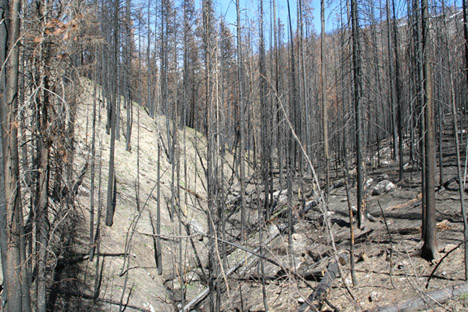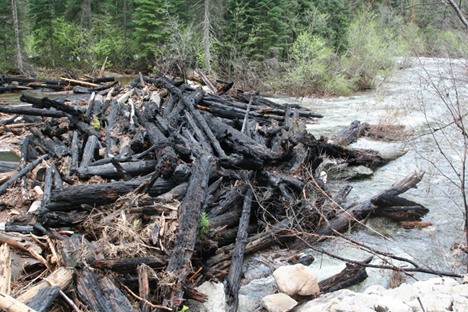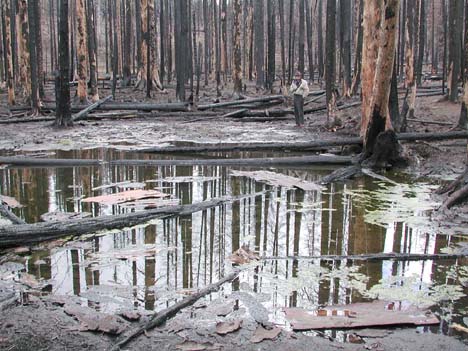Shall the USFS Allow Fires to Incinerate Our National Forests?
Part III
We continue our rebuttal of the recent 3-part series the Idaho Statesman that promoted the idea of allowing forest fires to burn unchecked.
Let It Burn is illegal, destructive of a multitude of forest and human values, is not cost-effective, and is the worst idea that ever came down the forest pike. Let me count the ways.
6. Let It Burn Has Significant Effects on Water and Watersheds
Forest fires have significant deleterious effects on water quality, stream flow, forest hydrology, and riparian and aquatic conditions. Allowing forest fires to burn unchecked leads to additional acreage burned, and additional impacts to water-related resources.
Water may be the most valuable resource produced by our national forests. Water yield and water quality from public lands are depended upon by agriculture and every major town and city in West. Degradation and pollution of streams and rivers is the most damaging aspect of catastrophic forest fires in dollar terms (even more than the destruction of flora, fauna, and heritage values).
Severe fires impact soils and cause erosion and mass wastage when rains return. Flash floods have occurred within the Zaca Burn (2007) and (already) the Piute Burn (2008) that have impacted communities far outside the burn areas. Landslides and mudflows have peppered central Idaho following the 800,000 acre burn of 2007 (multiple but contiguous fires), and this summer rivers are running chocolate with silt following every thundershower.
Among the effects of fire on soil and water are (this is a short list):
- Changes in infiltration due to collapse of soil structure, increase in bulk density, removal of organic matter, reduction in soil porosity, clogged soil pores, and increased reaction to rainfall droplet kinetics
- Decrease in soil wettability (hydrophobia), concretion, increased water repellence, increases in surface flow, increase soil particle transport, rilling, gulleying, and increased erosion
- Substantial changes in stream water chemistry, solid and dissolved material transport, pH, bacteriological characteristics, sediment influx and transport, dissolved sulfates, nitrates, nitrites, chlorides, iron, and other cations, and turbidity,
- Increases and decreases in discharge rates and seasonal streamflows, peak flows including flash flooding, minimum flows, as well as total annual streamflows,
- Degradation of aquatic habitat, aquatic biota, spawning gravels, fish populations, cultural resources, and human health and safety.
The Idaho fires were directly atop the Idaho Batholith, a composite mass of granitic plutons covering approximately 15,400 square miles in central Idaho. Batholiths are made of granite and are prone to mass wasting. Not only is the parent rock easily weathered, batholitic (granitic) soils are highly erodable. Increased erosion after a fire results from removal by incineration of the ground cover, including the tree canopies that intercept direct rainfall. In addition, cooked soils have more water repellency, which reduces water infiltration, increases runoff, and thereby also increases erosion. Studies have shown that sedimentation in streams can increase by a factor of seven or more after a fire (see Neary, Daniel G.; Ryan, Kevin C.; DeBano, Leonard F., eds. 2005. Wildland fire in ecosystems: effects of fire on soils and water. Gen. Tech. Rep. RMRS-GTR-42-vol.4. Ogden, UT: U.S. Department of Agriculture, Forest Service, Rocky Mountain Research Station).
The hydrology of the Idaho Batholith was severely impacted by Let It Burn fires that were anticipated but never evaluated by prior Environmental Impact Statements. The US Forest Service allowed fires to burn with minimal efforts to contain them, but those decisions were never made subject to the NEPA process or to public review and involvement.
Another important environmental law is the Clean Water Act of 1977 (subsequently amended numerous times). The CWA was established to eliminate releases of toxic substances into the waters of the US. Since inception of the CWA, $billions have been spent to clean up our streams, rivers, and lakes. Let It Burn fires counteract those efforts and nullify pollution control gains made at great expense and sacrifice.
The avoidance and eschewal of NEPA and the CWA in designating the Idaho national forests as “Let-It Burn laboratories” led to the greatest single disaster to Idaho forests and watersheds in nearly 100 years. By the way, it was the Idaho Statesman that reported on July 30, 2007:
MCCALL, Idaho — Western public lands, including the Payette National Forest in Idaho, the Gila National Forest in southwestern New Mexico and the Bitterroot National Forest that straddles the Montana-Idaho border, have become “let-it-burn laboratories,” federal wildfire managers say.
Sparse populations surrounding those forests make it possible to pursue some of the nation’s most progressive fire management policies.
An increasing number of wildfire managers are letting more lightning-caused fires on federal land burn, to help return forests to their natural state where wildfire and trees survived in equilibrium before modern man’s arrival. The policy also keeps firefighters from harm’s way — and could save millions of dollars otherwise spent fighting fires miles far from civilization.
But millions of dollars were not saved. Instead tens of $millions were spent and hundreds of $millions in watershed damages were realized. Those damages are still occurring and will continue to accumulate for decades.

Payette NF following the 2007 fires

South Fork of the Salmon River

Round Lake on the Deschutes NF following the B&B Fire (2003). Pictured is the late Dr. Ben Stout. Photo courtesy Oregon Websites and Watersheds.
7. Let It Burn Has Significant Effects on Air and Airsheds
It is well known that fires produce smoke, and smoke is a form of air pollution. Congress passed the Clean Air Act in 1963, the Air Quality Act in 1967, the Clean Air Act Extension of 1970, and Clean Air Act Amendments in 1977 and 1990 to limit air pollution in the US.
Wildfires produce air pollutants including particulates, hydrocarbons, sulfur
dioxide (SO2), nitrogen dioxide (NO2), ozone, carbon monoxide (CO) and lead (Pb), all regulated by the Clean Air Act.
Particulate matter, or visible smoke, is regulated through national ambient air quality standards (NAAQS) for Total Suspended Particulates (TSP). The standards for TSP cover a range of particles from 0 to 50 microns. Particulate matter of this size can remain suspended in the atmosphere for periods of a few seconds to several months. Suspended particulate matter is that portion of the TSP less than 10 microns in size (known as PM10) which is transported large distances downwind and can have the greatest impact on air quality. Impacts include significant deterioration of visibility, damage and soiling of properties, and human health effects (see Sandberg, David V.; Ottmar, Roger D.; Peterson, Janice L.; Core, John. 2002. Wildland fire on ecosystems: effects of fire on air. Gen. Tech. Rep. RMRS-GTR-42-vol. 5. Ogden, UT: U.S. Department of Agriculture, Forest Service, Rocky Mountain Research Station).
Ninety percent of smoke particles from wildfires are less than 10 microns (Ibid). Eighty two percent (82%) or smoke particles from wildfires are less than 1 micron (Ibid). Particles of this size can be trapped in alveoli in the lungs. Adults and children with asthma are seriously affected and their lives put at risk. Wildfire smoke has triggered public health alerts and advisories when particulate matter exceeds NAAQS thresholds. In addition to respiratory dangers, loss of visibility has been implicated in traffic accidents. (Ibid).
Wildfires frequently trigger public health and hazard alerts. California has been blanketed with choking smoke from wildfires for over two months. Smoke from Calif fires has created haze as far away as Portland, OR and Aspen, CO.
Allowing forest fires to burn for weeks and months rather than containing, controlling, and extinguishing those fires within hours or days adds to air pollution. Additional smoke from long-burning fires has significant impact on air quality and public health over long periods of time.
Prescribed burns by the USFS must meet stringent air quality standards, but Let It Burn fires are designated and allowed to burn with no consideration of the Clear Air Act in the slightest.
Recent studies have attempted to estimate and quantify the amount of air pollution generated by forest fires. Among those studies is the Forest Carbon and Emissions Model (FCEM) created by Dr. Thomas M. Bonnicksen, Ph.D. FCEM is a mathematical method (model) for estimating the amount of greenhouse gases (CO2, CH4, N2O) emitted by forest fires. FCEM requires minimum input of stand data, the number of acres burned, and the percent understory and overstory mortality. From those FCEM computes carbon stored and the emissions from fire combustion and from subsequent decay of dead wood (see Bonnicksen, T.M. 2008. Greenhouse gas emissions from four California wildfires: opportunities to prevent and reverse environmental and climate impacts. FCEM Report 2. The Forest Foundation, Auburn, California).
The FCEM model estimated that the 66,000 acre Moonlight Fire (2007) on the Plumas NF generated nearly 5 million tons of greenhouse gases. Fires in forests with significant biomass, such as the Plumas NF, can produce as much air pollution per acre as 15 automobiles driven all year.
Rough estimates of the greenhouse gas emissions from the 800,000 acre Idaho Batholith fires of 2007 are that 40 million tons of greenhouse gases were released or will be released as the dead wood decays. That is the equivalent of 8 million cars driven all year. More than 90 percent of Idaho carbon dioxide emissions come from forest fires.
Efforts to reduce greenhouse gases will fail miserably if megafires are encouraged. Efforts to reduce air pollution in general will also fail (indeed, have failed).
The Idaho Statesman series failed (another failure) to consider pollution of water and air from megafires. Narrow thinking is counter-productive to stewardship. There is a big picture that must be examined, and it includes the impacts of megafires on a variety of natural resources.
There are also impacts to public health and safety, recreation, and of course, economics. We will examine those impacts in Part IV.
To Be Continued …
Mike:
This is a very nice series, and will hopefully be used to enhance public and political debate on these topics.
Agency scientists have already become politicized on the issue and have proven unreliable as resource managers. It is time again for common sense and competent management to gain control of our public forests and wildfire events.
One minor correction: that is Ben Stout and not Bill Hagenstein standing along snowmelt on the shore of Round Lake following the B&B Fire. Bill (and Ben) was present at a subsequent ORWW tour of the area, see [here].
The culverts and bridges that were installed with BAER money following the B&B Fire ignored the volcanic nature of the affected soils which absorb snowmelt rather than creating torrents, as declared by BAER scientists and USFS representatives, see [here].
Caption corrected. Thank you.
by Joe B.
If you saw the East Fork of the South Fork of the Salmon River on July 21 you were a lucky person then and a sad person today. I last saw it on June 27. What I looked at on July 24 was not clear running water; it was the remnants of a mountain clogging a river bed.
Gigantic sandbars, logjams that made lakes, a side pond completely filled with mud. Mudslides up to 30 feet deep in places. Boulders the size of SUVs strewn about like a child’s toys. Large trees dislodged and replanted sideways and upside down. Mountain drainages scraped to bed rock and widened beyond belief.
And the Payette Forest says they expected this. Yeah well, it ain’t rocket science to know when you’ve screwed up royally.
And who pays for their mismanagement? Every damn American taxpayer, that’s who. And the people who are forced to live with this disaster, the previous disaster, and the disasters that will follow are made to feel guilty that they dared live anywhere near the Wilderness Society’s incineration zones.
Americans cannot get angry enough to suit me. There is no anger deep enough to assuage this carnage, nor can it be mustered.
America look at what you are paying for and choke on it. Gag on it, dry heave until your innards are dangling from your lips.
The demonic plague has come and there will be nothing left. And the damn bureaucrats want credit for what they have allowed to happen.
The Forest Service is poisoning American forests and watersheds while the Wilderness Society supplies the arson-ic.
Joe:
Forgive them, for they know not what they do.
We are dealing with a bunch of self-serving, inexperienced idiots (dictionary definition; not name-calling) who don’t have a clue as to what the outcomes of their actions will be. We just know that bureaucrats will ALWAYS try to take credit for anything that happens for which they might be held accountable. They actually DO very little else, for the most part.
The very best of the breed get elected to office, or are politically appointed to their positions. Lesser functionaries depend largely upon age, sex, race, military service, and/or disability for their check from the taxpayers. Knowledge and experience are typically more detrimental than helpful in acquiring such positions — at least that has been the case during the past 20-30 years.
The whole situation is nuts, but rural residents of Oregon and Idaho have no political standing. Less than a spotted owl or its legal representative. How to change? Common sense and ability used to be important commodities. Now it’s word games.
by bear bait
Bob: I have an easy answer: scrap the whole of the USFS now. And then rebuild on the strong ranger model of old. Luddite that I appear, that system worked. Far fewer people, and care and preservation of the resource the goal.
Like in the old days, the forest today with manned lookouts and one room satellite ranger cabins accessible by horse or shank’s mare, with satellite phone connections, transmittable maps, photos, what have you, you can have two person fire crews on every lightning strike most of the time in a couple of hours. You can have people doing trail maintenance in the meantime. You go back to another time, and do the work by hand. The labor cost cannot come close to what fire fighting costs are today, and the public gains sovereignty over the forest, has people out there accounting for conditions, comforts, and resource values. “Boots on the ground” as it were. You site the cabins on administrative sites, which I believe can still be done under the old Organic Act.
Lightning fires in the summer are the worst fire treatment possible. There are some low resource value area fires, like timberline fires, or fires in rockpiles, those can burn in summer. If you want fire in the forest, introduce it in spring on wet ground over controlled areas. And then put it out before summer’s heat and winds. If a fall fire is better, then you wait for the first of the winter storms, and use helicopter ignition over a wide area, knowing no matter how jackass things become, it will be a handful of days or even hours before winter puts the fire blanket on it all.
I talked to a college kid doing required spotted owl census work in the second growth industrial forests of the NW, and he says the more managed the stand, the better thinned it is, the more owls they see. The most owls they are finding are in multiple entry thinned 60 year old conifers. Many more than on areas with older stands, and non-managed stands. And way more than they find in old growth areas. (He was the best man at a wedding and in his toast, he mentioned his work, and got roundly booed. Too many timber beasts at the wedding, I guess.)
The point is that ESA protected species thrive in managed forests in many instances. They do not thrive in a sea of black snags and burnt rocks, with no food for their prey base. Doing nothing is a management alternative that our Western forests have not evolved with, nor have they benefited from no human influences. Aboriginal peoples set fires, on purpose and by accident, for thousands of years before most Americans got here.
You hire strong, fit, determined people, with forest science education, and they will make good decisions on the spot most of the time. Even the most experienced people can get it wrong some time. But by growing an independent, innovative, free thinking person with a purpose, and he or she not being micromanaged by higher ups, wonderful thinks happen. You know how the Googles, Microsofts, Ebays of the world have been formed. Hard working young people with a goal figured out how to get there from here. You keep the bench-butted judges, the NGOs, the old agency whores out of the picture, and a good group of hard working young people could get a world of good accomplished. And do it with primitive tools and ingenuity, and meaningful hard work. Tactile, visible, substantive results of labor are perhaps the greatest reward humans might enjoy. Pride of ownership of a job well done. You just don’t know how much that can change people and a country.

For more about the effects of forest fires on water resources see To Log or Not to Log — Water Is the Question [here].
For more on calculating air pollution emissions from forest fires see The Forest Carbon and Emissions Model (FCEM) [here].